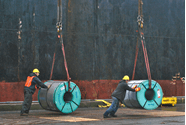Product

January 22, 2019
West Coast Mills Announce; Inventories Key in the East
Written by John Packard
On Monday, California Steel Industries (CSI) and USS/POSCO (UPI) advised customers of their intention to take spot prices on flat rolled products produced by the two mills up by $40 per ton ($2.00/cwt). This is the first price announcement out of either mill since October 2018. So far, there have not been any announcements out of the domestic mills located east of the Rocky Mountains.
Many steel buyers told Steel Market Update Publisher John Packard, during his channel checks over the past two days, of limited buying activity. A large hot rolled buyer told SMU on Monday, “We are not buying a whole lot. Apparent demand is lacking, and the next phase will be to watch import.” This buyer went on to say that lead times have been deteriorating and are the shortest they have seen on the products they buy going back to October 2017. It was then that momentum changed and prices started to run up (aided a little later by Section 232 tariffs).
This particular hot rolled buyer told SMU, “Every pound that was bought [for 4Q delivery] doesn’t look like a good deal. I would much rather be buying today.” He now believes HRC prices are close to the bottom and the new risk will most likely be to the upside.
A trading company with whom we communicated earlier today used the old, “You don’t want to catch a falling knife” analogy when talking about steel buyers sitting back and waiting.
SMU wrote about the position the trading companies find themselves in last week. The expectation is for foreign imports to drop another 10 percent or so on flat rolled products during the first half 2019 based on what we heard from traders last week.
A large cold rolled steel service center told us their business is flat so far in January, even though their forecast was for business to be higher in 2019. This executive thought one of the East Coast mills might make a move. However, “it doesn’t seem like the right time [in the current market].” He went on to speak about the uncertainty in the market: Brexit, China, trade wars, 401k’s losing value, inability to see the import statistics…. “People are nervous” and nervous people don’t want to buy extra steel. (ARTICLE CONTINUES BELOW)
{loadposition reserved_message}
The CRC buyer told us foreign offers at $38.50/cwt for Korean material didn’t make any sense. The spreads between domestic and foreign are just not there. (He put domestic at $38.00/cwt for spot last week, maybe lower this week if they had tons to buy).
Other steel executives pointed to the high inventory levels being carried by the flat rolled and plate steel service centers as problematic. Higher inventories and lower lead times mean buyers will sit on their hands. The incentive to buy just doesn’t exist. Will the CSI and UPI price announcements move momentum?
The owner of a medium-sized service center in the Midwest said that inventories are the key. If inventories fall this month, this could prompt service centers to do a little bit of buying. Especially if the spreads between foreign and domestic are such that it doesn’t make sense to buy foreign steel (thus tightening the market even further).
At SMU, we can sense the anxiety growing amongst the steel buyers as they review their inventories (SMU has flat rolled at 2.7 months of supply) and try to gauge how much foreign will be coming in January and February. The government shutdown has definitely put a cloud over the imports market since no data has been available over the past month.
Steel buyers need to continue to remain vigilant and watch lead times out of the mills, the willingness of the mills to negotiate spot prices and inventories and how service centers are handling spot prices to their customers. This market will bottom at some point and those four indicators will help point out the direction and timing.
SMU is conducting our mid-January flat rolled and plate steel market trends analysis right now and we will report lead times and negotiations, as well as our Sentiment Indices, in Thursday evening’s issue of Steel Market Update.







